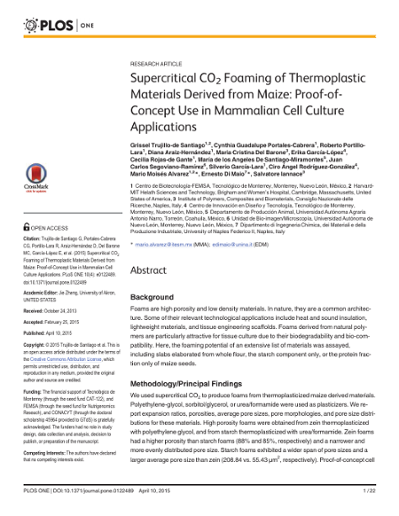| dc.creator | Erika García López | |
| dc.creator | Roberto Portillo Lara | |
| dc.creator | Diana Araiz Hernández | |
| dc.creator | Silverio García Lara | |
| dc.creator | Mario Moisés Alvarez | |
| dc.creator | Ciro Angel Rodríguez González | |
| dc.date | 2015 | |
| dc.date.accessioned | 2018-10-18T20:34:50Z | |
| dc.date.available | 2018-10-18T20:34:50Z | |
| dc.identifier.issn | 19326203 | |
| dc.identifier.doi | 10.1371/journal.pone.0122489 | |
| dc.identifier.uri | http://hdl.handle.net/11285/630372 | |
| dc.description | Background Foams are high porosity and low density materials. In nature, they are a common architecture. Some of their relevant technological applications include heat and sound insulation, lightweight materials, and tissue engineering scaffolds. Foams derived from natural polymers are particularly attractive for tissue culture due to their biodegradability and bio-compatibility. Here, the foaming potential of an extensive list of materials was assayed, including slabs elaborated from whole flour, the starch component only, or the protein fraction only of maize seeds. Methodology/Principal Findings We used supercritical CO<inf>2</inf> to produce foams from thermoplasticized maize derived materials. Polyethylene-glycol, sorbitol/glycerol, or urea/formamide were used as plasticizers. We report expansion ratios, porosities, average pore sizes, pore morphologies, and pore size distributions for these materials. High porosity foams were obtained from zein thermoplasticized with polyethylene glycol, and from starch thermoplasticized with urea/formamide. Zein foams had a higher porosity than starch foams (88% and 85%, respectively) and a narrower and more evenly distributed pore size. Starch foams exhibited a wider span of pore sizes and a larger average pore size than zein (208.84 vs. 55.43 μm2, respectively). Proof-of-concept cell culture experiments confirmed that mouse fibroblasts (NIH 3T3) and two different prostate cancer cell lines (22RV1, DU145) attached to and proliferated on zein foams. Conclusions/Significance We conducted screening and proof-of-concept experiments on the fabrication of foams from cereal-based bioplastics. We propose that a key indicator of foamability is the strain at break of the materials to be foamed (as calculated from stress vs. strain rate curves). Zein foams exhibit attractive properties (average pore size, pore size distribution, and porosity) for cell culture applications; we were able to establish and sustain mammalian cell cultures on zein foams for extended time periods. © 2015 Trujillo-de Santiago et al. | |
| dc.language | eng | |
| dc.publisher | Public Library of Science | |
| dc.relation | https://www.scopus.com/inward/record.uri?eid=2-s2.0-84929493649&doi=10.1371%2fjournal.pone.0122489&partnerID=40&md5=53c405a90eda8b4f4840cc0b282ed608 | |
| dc.relation | Investigadores | |
| dc.relation | Estudiantes | |
| dc.rights | info:eu-repo/semantics/openAccess | |
| dc.rights.uri | http://creativecommons.org/licenses/by-nc-nd/4.0 | |
| dc.source | PLoS ONE | |
| dc.subject | carbon dioxide | |
| dc.subject | formamide | |
| dc.subject | glycerol | |
| dc.subject | macrogol | |
| dc.subject | plastic | |
| dc.subject | plasticizer | |
| dc.subject | sorbitol | |
| dc.subject | starch | |
| dc.subject | thermoplastic | |
| dc.subject | unclassified drug | |
| dc.subject | urea | |
| dc.subject | vegetable protein | |
| dc.subject | zein | |
| dc.subject | biomaterial | |
| dc.subject | 22RV1 cell line | |
| dc.subject | 3T3 cell line | |
| dc.subject | animal cell | |
| dc.subject | Article | |
| dc.subject | assay | |
| dc.subject | cell adhesion | |
| dc.subject | cell culture | |
| dc.subject | cell proliferation | |
| dc.subject | DU145 cell line | |
| dc.subject | fibroblast | |
| dc.subject | flour | |
| dc.subject | foam | |
| dc.subject | foaming | |
| dc.subject | maize | |
| dc.subject | mammal cell | |
| dc.subject | mouse | |
| dc.subject | nonhuman | |
| dc.subject | plant seed | |
| dc.subject | porosity | |
| dc.subject | prostate cancer cell line | |
| dc.subject | supercritical carbon dioxide foaming | |
| dc.subject | animal | |
| dc.subject | cell culture technique | |
| dc.subject | cell line | |
| dc.subject | human | |
| dc.subject | materials testing | |
| dc.subject | temperature | |
| dc.subject | Mammalia | |
| dc.subject | Zea mays | |
| dc.subject | Animals | |
| dc.subject | Biocompatible Materials | |
| dc.subject | Carbon Dioxide | |
| dc.subject | Cell Culture Techniques | |
| dc.subject | Cell Line | |
| dc.subject | Humans | |
| dc.subject | Materials Testing | |
| dc.subject | Mice | |
| dc.subject | Porosity | |
| dc.subject | Temperature | |
| dc.subject | Zea mays | |
| dc.subject | Zein | |
| dc.subject.classification | 7 INGENIERÍA Y TECNOLOGÍA | |
| dc.title | Supercritical CO2 foaming of thermoplastic materials derived from maize: Proof-of- concept use in mammalian cell culture applications | |
| dc.type | Artículo | |
| dc.identifier.volume | 10 | |
| dc.identifier.issue | 4 | |
| refterms.dateFOA | 2018-10-18T20:34:50Z | |

